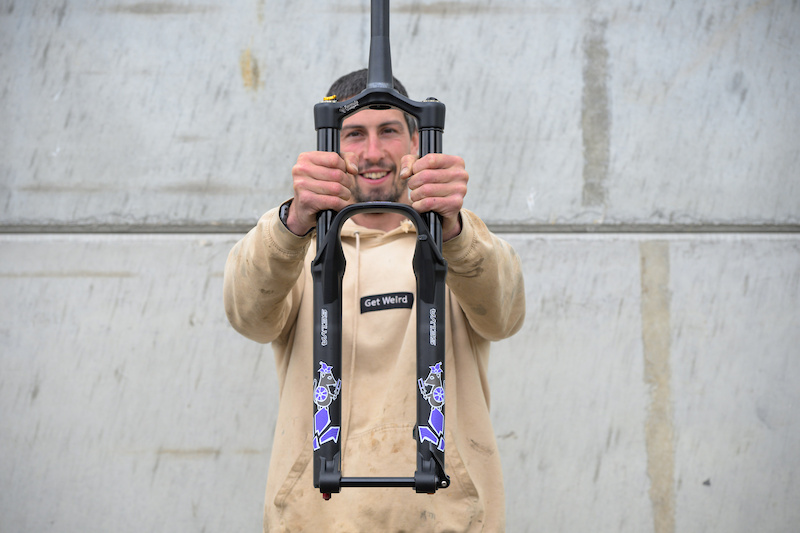Each fork comes with a Compression Tuning System (CTS) valve that was created specifically for Bryceland, who asked Formula’s engineers for something with good grip at the beginning of the stroke and then plenty of ramp up for bigger hits.
• Travel: 170mm
• Wheel size: 29″
• 43mm offset
• A2C: 585mm
• 35mm stanchions
• Custom Compression Tuning System valve
• Includes pump, tools, travel spacers, 2 additional CTS valves
• Weight: 2020 grams
• Price: 1514 EUR, 1279 GBP, 1750 CAN
• rideformula.com
The CTS system is novel in that it only takes a few minutes to swap a valve – if a rider ends up purchasing this limited edition fork (only 100 are being produced) and then realizes that they don’t ride like Josh, it’s a quick procedure to install one of the two standard CTS valves that are also included.
The Bryceland-edition Selva is available with 170mm of travel for 29” wheels, and is priced at 1514 EUR. My test fork with the thru-axle installed weighed in at 2020 grams. The Selva is covered by a 2-year transferable warranty, as well as Formula’s 10 year support promise, which says that every product they make will have parts, spares, and support available for 10 years.
Fork Details
Along with the custom CTS valve, the air-sprung Selva has a new larger volume positive air chamber that’s intended to give the fork a more linear spring curve. This version of the Selva uses a three-stage coil negative spring underneath the positive air chamber, where the springs get stiffer towards full extension in order to prevent any noticeable topout. Formula’s CTS valves and Neopos volume spacers are the two ingredients that ensure the fork doesn’t bottom out harshly.
For those who aren’t familiar, Neopos are volume spacers made of foam rather than that hard plastic that’s typically used. That foam compresses as the air pressure inside the positive chamber increases, which creates a more gradual end stroke ramp. It still acts like a volume spacer, though, so removing it may still be necessary to achieve full travel depending on the fork setup.
The rebound knob is located in the typical location, on the underside of the right leg, and there are 18 clicks of adjustment. The tool-free quick-release lever on the thru-axle is removable; once it’s taken off the axle can be tightened or loosened with a 5mm Allen wrench.
Ride Impressions
I started off with the Bryceland CTS valve installed and the fork inflated to 65 psi as per Formula’s recommendation. I headed out on one of my usual test loops, a ride that includes a good mix of jumps, drops, berms, and some steeper, more natural trails. In other words, a mountain bike ride.
Not that I had any doubts before, but that ride reinforced the fact that no, I’m not Josh Bryceland. Formula definitely achieved the goal of having a soft, supple initial stroke and then tons of support after that, but the extreme ramp up meant that I was only using around 140 millimeters of travel, and that was on a ride with plenty of hard drops and G-outs that would have used almost full travel on my typical setup. The softer initial part of the travel meant that I wasn’t getting bounced around, but the ramp-up deeper in the travel was very, very noticeable – it was like running into a padded wall, and no matter how hard I pushed I couldn’t get through it.
Time to swap the CTS valve for something better suited to a mere mortal. I tried both the orange and gold valves, eventually settling on the gold valve with no spacers as my preferred all-round setup. As it turns out, Formula says that valve is what 75% of their customers prefer. If I was on an e-bike, or knocking out high-speed bike park laps I could see going with the orange valve, due to the extra mid- and end-stroke support it provides. With the gold valve, the fork had excellent grip off the top, and the support built nicely throughout the travel.
Formula’s CTS system makes it easy to experiment with different setups, and it’s a clever way to give riders a wide range of noticeably different fork configurations. With the Bryceland Selva, I can’t help but wonder if this the final push for this model before something new is released. Don’t get me wrong, it works very well; other than the fairly loud rebound noise I don’t have any complaints about its performance, it’s just partially overshadowed by the newest offerings from Fox and RockShox.
The Selva’s stanchions still measure 35mm, and while the chassis was certainly stiff enough for my 160 lb weight, I could see bigger riders gravitating towards the burlier 38mm options out there. The flip side is that the Selva weighs around 300 grams less than a Zeb or 38, which is a significant weight savings – something to keep in mind for riders who are tired of their enduro bike weighing as much as a downhill bike.
Bleeder valves would be a nice touch, and I also don’t think the lockout lever is necessary on a long travel fork. I wouldn’t consider any of those deal breakers, though, and for riders interested in trying something a little different the Selva is worth considering.

